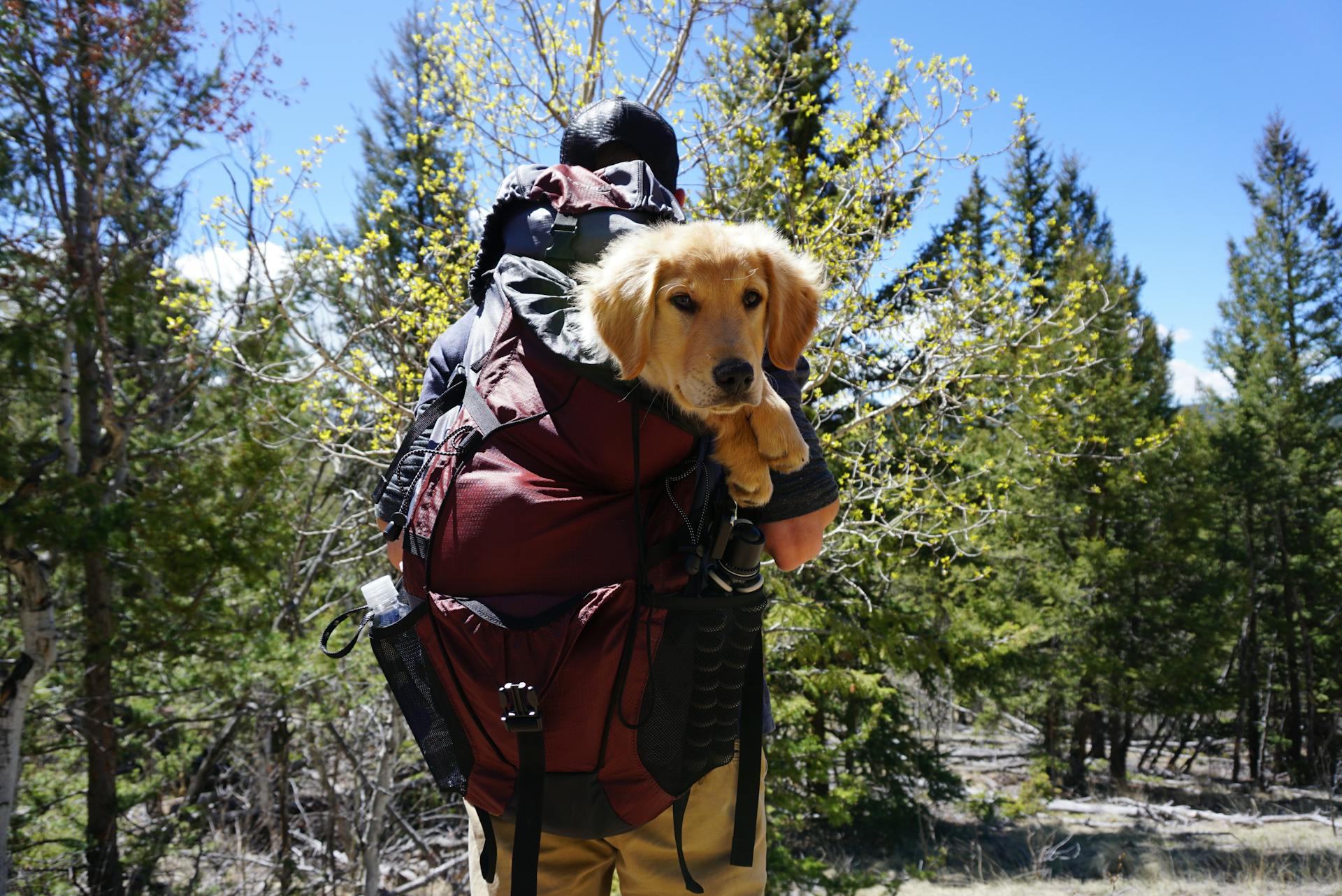
Accidentally giving your dog a double dose of flea medication can be a stressful experience, but knowing what to do next can help minimize the harm. According to one study, a double dose of flea medication can cause vomiting, diarrhea, and lethargy in dogs.
Symptoms of an overdose can appear within 30 minutes to an hour after administration. If your dog is showing signs of an overdose, it's essential to remain calm and act quickly.
If you suspect your dog has ingested a double dose, contact your veterinarian or a pet poison hotline immediately. They can provide guidance on the best course of action and help you determine the severity of the situation.
Consider reading: Dog Flea Treatment Overdose Symptoms
What Happens When You Make a Mistake
If you accidentally give your dog a double dose of flea medication, it can be a serious mistake. Substances that are toxic to fleas and ticks can also be harmful to pets when consumed or applied in large quantities.
The active ingredients in flea and tick medications, such as pyrethrins, synthetic pyrethroids, and isoxazolines, can cause toxicity if given incorrectly or if an overdose occurs. Isoxazoline-containing preventives, like Bravecto and NexGard, are highly effective but can be toxic if not used as directed.
If the product is labeled for cats, do not give it to your dog – or vice versa. This can also lead to toxic quantities being absorbed by your pet.
Explore further: Flea Medicine Not Working on Dog
Errors Easily Made
Unclear medical abbreviations are a common cause of medication errors in veterinary medicine. These abbreviations can be misinterpreted by pharmacists or pet owners, leading to serious consequences.
A pharmacist in a human pharmacy may not be familiar with certain veterinary abbreviations for different dosage amounts. For example, the abbreviation "SID" (once daily) was misinterpreted as "BID" (twice daily) and "QID" (four times daily), resulting in drug overdoses.
Problematic abbreviations such as "u" (units) or the Greek letter μ (mu) could be mistaken for the letter "o" or a number zero “0”. The "mcg" abbreviation for microgram could be mistaken as "mg" (milligram).
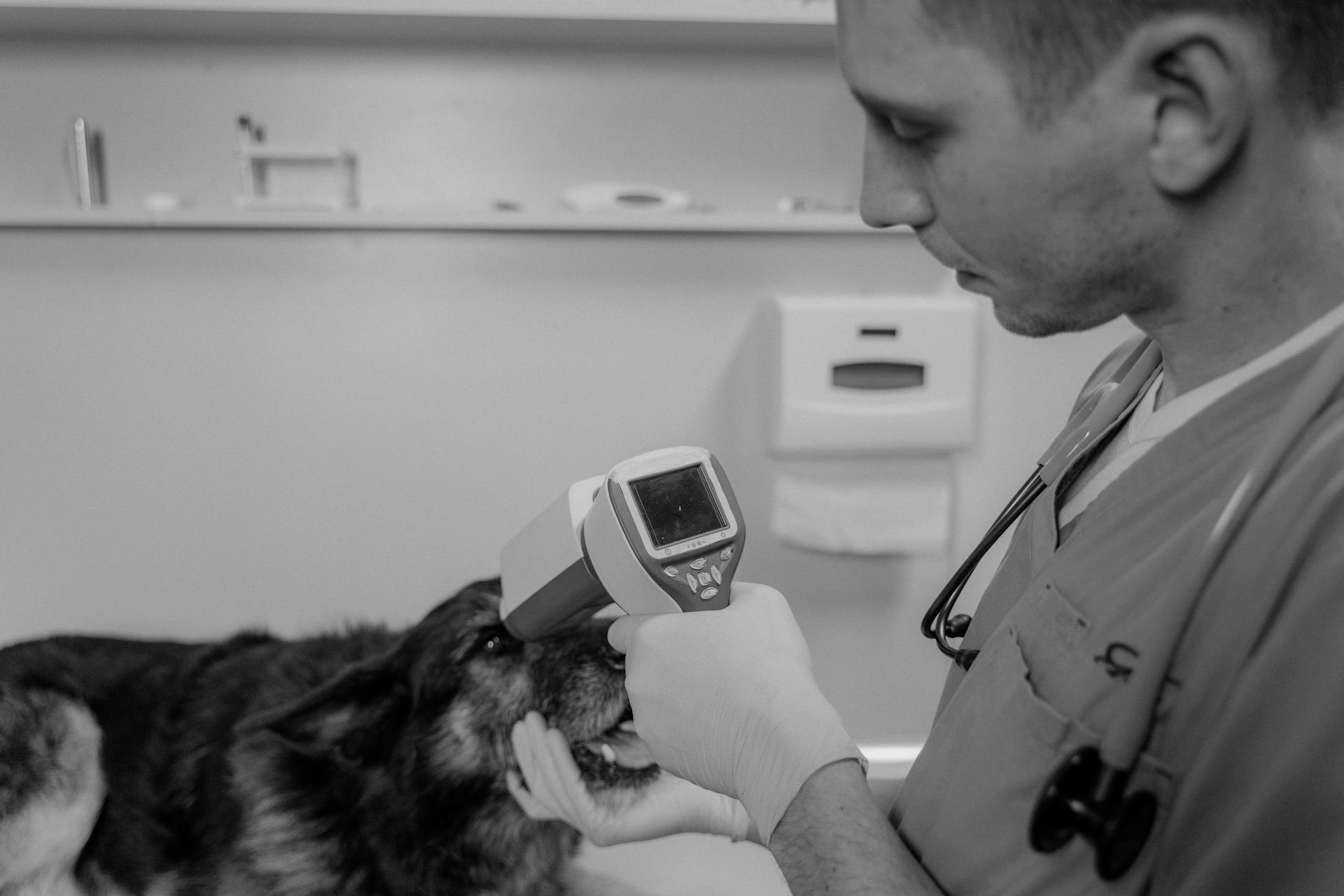
A 5 mg dose written as 5.0 mg can be misread as 50 mg, potentially resulting in a 10-times overdose if the order is not clearly written.
Here are some examples of how medication errors can occur due to unclear abbreviations:
- "SID" misinterpreted as "BID" or "QID"
- "u" or μ mistaken for "o" or "0"
- "mcg" mistaken for "mg"
- "5.0 mg" misread as "50 mg"
These errors can have serious consequences, especially when it comes to medications with a strong correlation between the dose and the severity of side effects.
What Happens If I Miss a Dose?
If you miss giving a dose, don't panic. Give the missed dose as soon as you remember.
If it's almost time for the next dose, skip the one you missed and move on to the next scheduled dose. Don't give a double dose unless your veterinarian says it's okay.
Missing a dose can be stressful, but in most cases, it's not a big deal. Just get back on track with the regular dosing schedule.
Symptoms and Causes
Symptoms of a double dose of flea medication in dogs can be alarming and even life-threatening.
Scratching and intense itchiness are among the earliest symptoms, which can develop within 15 minutes to several hours after ingestion or application.
Dogs may also exhibit restlessness, rolling around on their back or trying to bite the back, and vocalization, crying, or whimpering.
In severe cases, redness, hair loss, and future scarring at the site of application can occur.
Here are some of the possible symptoms your dog may experience:
- Scratching/intense itchiness
- Restlessness
- Vocalization, crying, whimpering
- Redness, hair loss and future scarring and site of application
- Drooling
- Vomiting
- Lack of appetite
- Gagging or hacking
- Agitation
- Muscle tremors
- Difficulty standing or walking
- Weakness
- Seizures
- Death
Symptoms
Symptoms of flea and tick medicine poisoning in dogs can be quite distressing, and it's essential to recognize the signs early on. If your dog is experiencing intense itchiness, it could be a sign of poisoning.
Scratching and rolling around on the back are common behaviors exhibited by dogs who are suffering from flea and tick medicine poisoning. These symptoms can develop within 15 minutes to several hours after ingestion or application.
Restlessness and vocalization, such as crying or whimpering, are also possible symptoms of poisoning. If you notice your dog exhibiting these behaviors, it's crucial to seek immediate veterinary care.
Check this out: What Does Flea Infestation Look like on a Dog
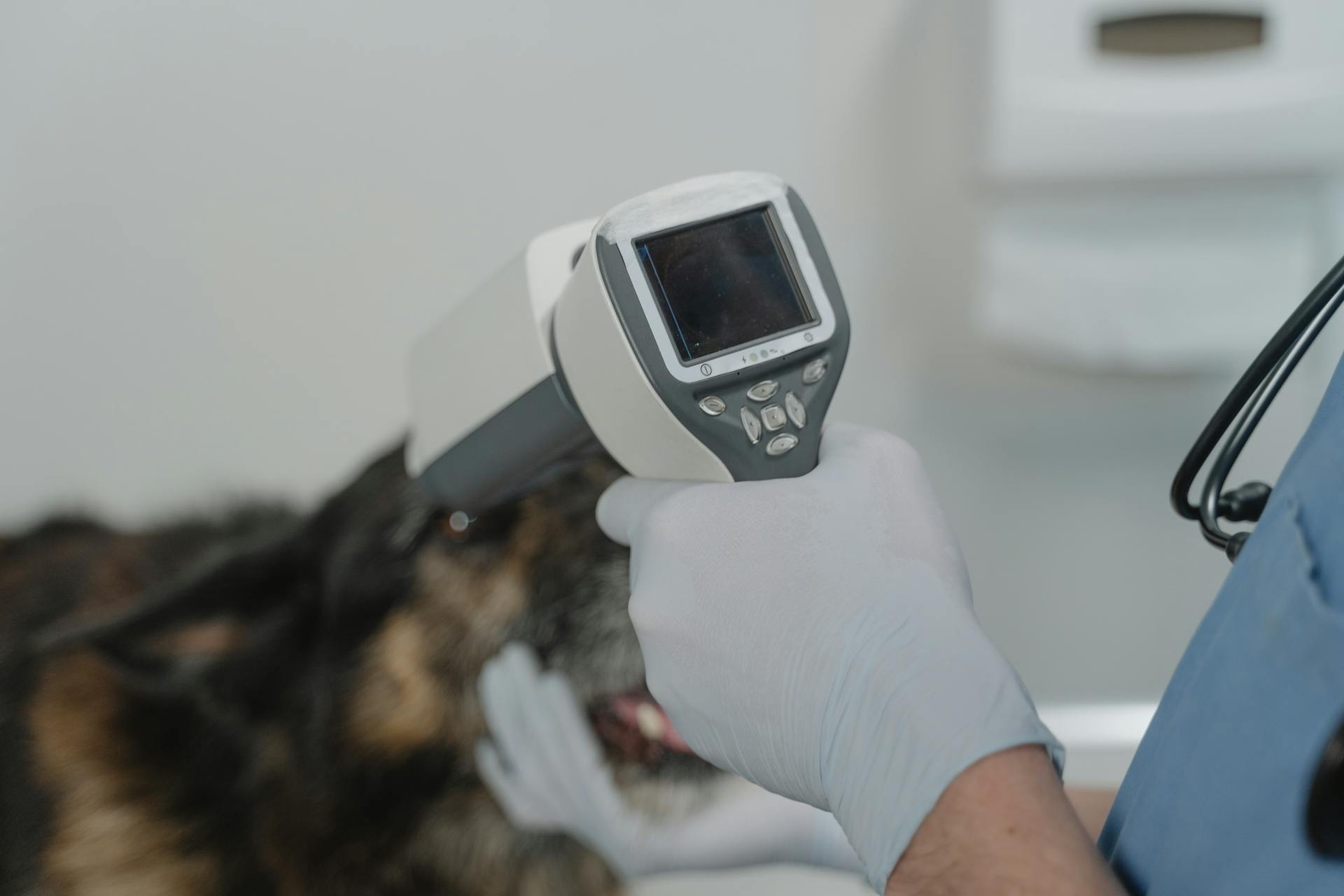
Redness, hair loss, and scarring at the site of application are physical signs of poisoning. These symptoms can be severe and potentially long-lasting.
Drooling, vomiting, and a lack of appetite are all potential symptoms of flea and tick medicine poisoning. If you notice any of these symptoms in your dog, it's essential to contact your veterinarian or a pet poison hotline immediately.
Some dogs may experience more severe symptoms, such as muscle tremors, difficulty standing or walking, weakness, and seizures. In the most extreme cases, flea and tick medicine poisoning can even be fatal.
Here are some common symptoms of flea and tick medicine poisoning in dogs:
- Scratching/intense itchiness
- Restlessness
- Rolling around on the back or trying to bite the back
- Vocalization, crying, whimpering
- Redness, hair loss and future scarring and site of application
- Drooling
- Vomiting
- Lack of appetite
- Gagging or hacking
- Agitation
- Muscle tremors
- Difficulty standing or walking
- Weakness
- Seizures
- Death
Causes
Dogs can become poisoned through the misuse of flea and tick prevention. This often happens when the wrong product is used or the incorrect dose is given.
It's essential to verify the correct drug, dose, and size of the product before medicating your dog. Make sure to check the expiration date too, as expired medications can be hazardous.
Never cut larger sizes into smaller pieces or give multiple smaller doses, as this can lead to an overdose.
Diagnosis and Treatment
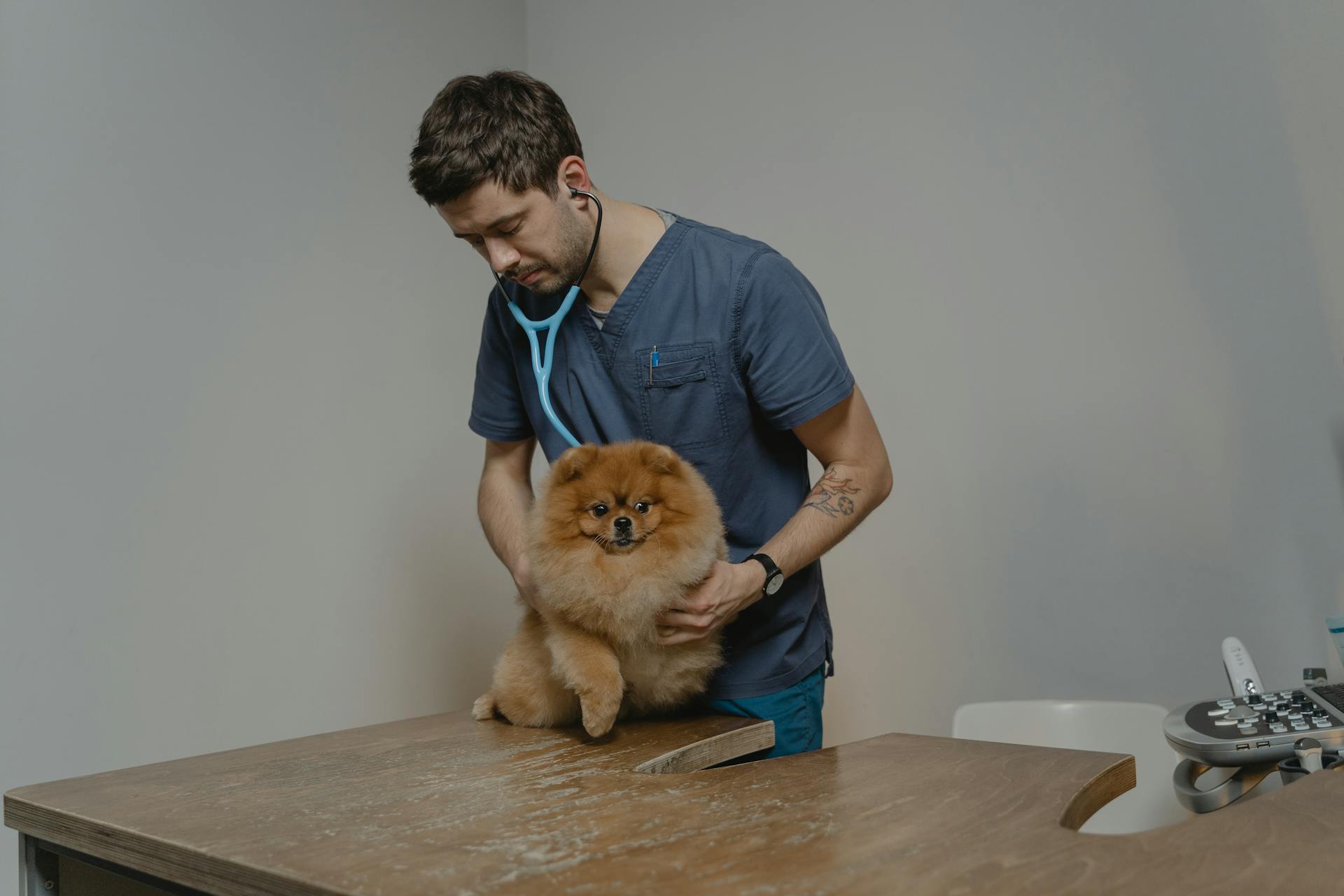
A veterinarian will make a presumptive diagnosis if there is a known or possible history of exposure to a flea/tick medicine product or ingestion of the medicine.
Your veterinarian will perform a complete physical examination to assess your dog's condition and look for signs of poisoning.
Blood work and urine testing may be done to rule out other possible causes of your dog's symptoms.
Treatment for flea and tick medicine poisoning typically involves quick removal of the product from your dog's skin and mouth.
To do this, you'll bathe your dog with a liquid dish soap like Dawn, Joy, or Palmolive to get the greasy substance off, and then rinse the mouth with copious amounts of water.
In severe cases, your veterinarian may recommend hospitalization to provide supportive care, which can include repeat bathing, intravenous fluids, anti-nausea medications, muscle relaxation, and seizure medication.
Your veterinarian will also monitor your dog's temperature, blood sugar levels, and kidney function to ensure they're not affected by the toxicity.
How Veterinarians Diagnose
A veterinarian's diagnosis often starts with a complete physical examination of your dog. This is a crucial step in identifying any potential issues.
If there's a known or possible history of exposure to products containing pyrethrin or pyrethroid, or ingestion of flea/tick medicine, a veterinarian will make a presumptive diagnosis. A presumptive diagnosis means the vet has a good reason to believe something is causing the problem, but can't prove it with a specific diagnostic test.
Blood work and urine testing may help rule out other possible causes of your dog's symptoms. These tests can provide valuable information to support or rule out a diagnosis of flea and tick medicine poisoning.
Treatment
Treatment for flea and tick medicine poisoning in dogs typically starts with quick removal of the product, which can be done by bathing your dog with a liquid dish soap like Dawn, Joy, or Palmolive to get the greasy substance off.
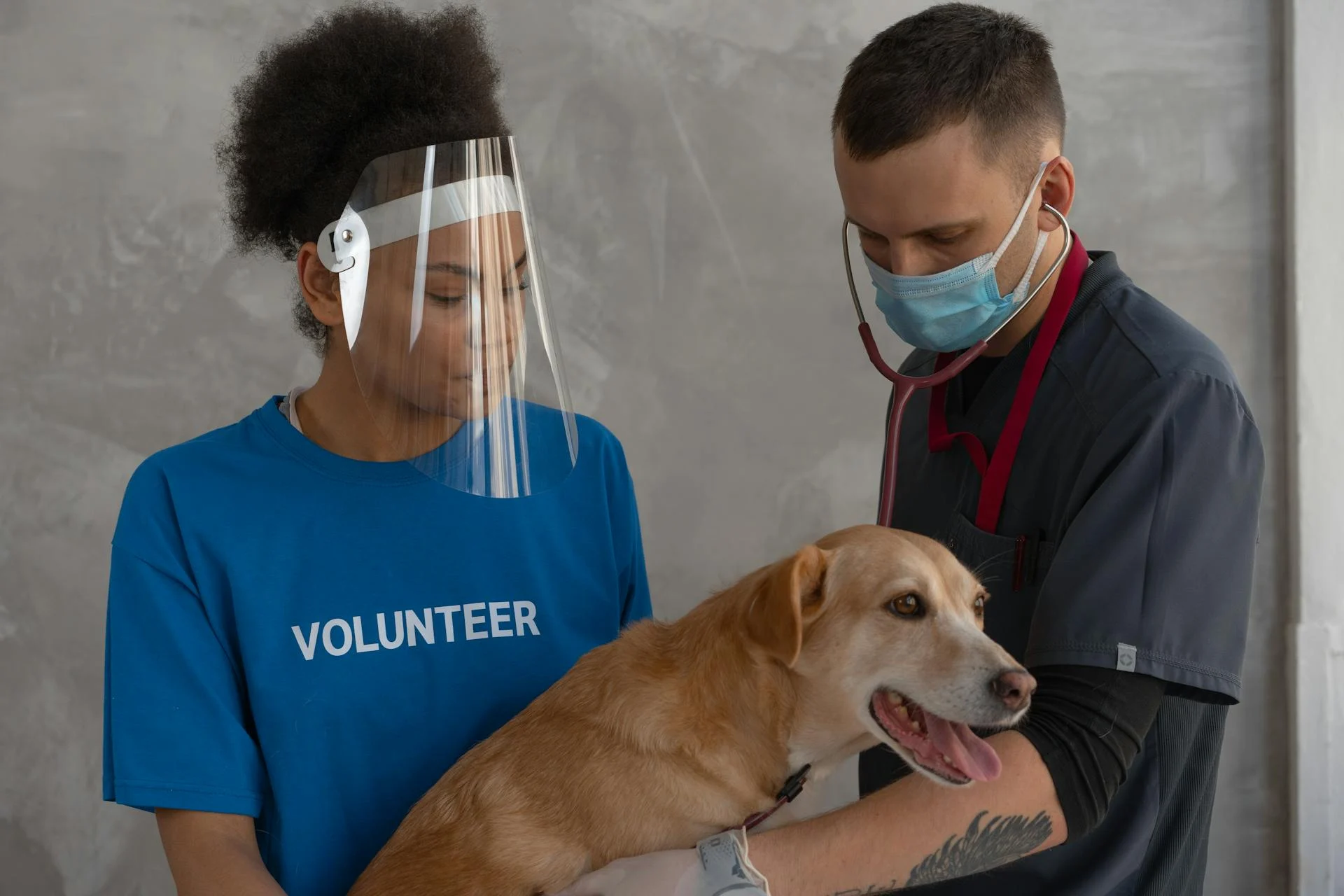
This helps to flush the toxins out of your dog's system. If your dog has ingested any of the product, use a garden hose to help rinse the mouth with copious amounts of water.
In some cases, hospitalization may be necessary to minimize the extent and severity of neurologic signs. This could require several days of care.
Your veterinarian may also recommend supportive care, which can include repeat bathing, intravenous fluids, anti-nausea medications, muscle relaxation, and seizure medication.
Here's a breakdown of the supportive care your veterinarian might recommend:
- Repeat bathing
- Intravenous (IV) fluids
- Anti-nausea medications
- Muscle relaxation
- Seizure medication
Your veterinarian will also want to monitor your dog's temperature, blood sugar levels, and kidney function, since these can be affected by toxicity in dogs.
Recovery and Prevention
If you accidentally gave your dog a double dose of flea medication, it's essential to monitor their behavior and health closely.
Symptoms of an overdose can include vomiting, diarrhea, lethargy, and seizures.
Keep an eye out for these signs and seek veterinary attention immediately if you notice any of them.
In some cases, an overdose can cause liver damage, which may not be immediately apparent.
To prevent accidental overdoses, always follow the instructions on the flea medication packaging and only administer the recommended dose.
Recovery and Management

Prompt recognition and early treatment is key to a good prognosis.
Excessive drooling, paw flicking/scratching, and ear twitching are often mild adverse reactions that can go away on their own.
Drooling may recur for several days after using a flea-control product.
Most mild to severe symptoms resolve within a few days.
Tick Infestation Prevention
To prevent tick infestations, follow the directions on flea and tick preventives carefully, ensuring your dog only receives his prescribed medication based on body weight.
Always use one flea and tick preventive at a time, as using multiple drugs can cause an accidental overdose and interact with other medications.
Don't use part of a larger dose or multiple smaller doses, as this can lead to an overdose and increased risk of poisoning.
If you're unsure about the correct dose, consult with your veterinarian for proper guidance.
Consider reading: Can You Use Dog Flea Medicine on Cats
Medication and Risks
Most topical flea and tick treatments contain pyrethrins or pyrethroids, which can be neurotoxins if over-applied.
These chemicals can cause serious adverse reactions in dogs and cats, including profuse drooling, vomiting, and seizures.
The Animal Poison Control Center lists common symptoms of poisoning, which include tremoring, hyperexcitability, agitation, and difficulty breathing.
Treatment for pyrethrin poisoning includes immediate removal of the product by bathing and emergency veterinary care.
Cats are very sensitive to pyrethrin, and spot treatments made for dogs should never be used on cats.
Common Symptoms of Pyrethrin Poisoning:
- Profuse drooling
- Vomiting
- Tremoring
- Hyperexcitability
- Agitation
- Seizures
- Weakness
- Difficulty breathing
Getting Medication Right
Reading the label is crucial when applying any medication to your pet. It's worth the time to make sure you do it right.
Don't use a product for dogs on cats or a product for cats on dogs. These animals have their own physiology and sensitivities to things.
You should apply medications to healthy pets only. If your pet is sick, talk to your veterinarian first.
If your pet is debilitated, meaning they're ill or under the weather, don't use the product. Signs of illness in pets can include not eating, not drinking, vomiting, diarrhea, a history of weight loss, illness, sneezing, coughing, and weakness.
Discover more: Can You Use Dog Flea Collars on Cats
Make sure the medication fits your pet's weight range. You can do this by weighing yourself, then considering your weight and your pet's weight. Subtract your weight from the total to get your pet's weight.
Older animals have an increased risk of illnesses. Generally, animals greater than eight years for small dogs and cats and five years for giant breeds should not use these products without consulting their veterinarian.
Certain medications have similar mechanisms of action. Avoid double dosing by not adding more medications from different products or adding to the same topical. Adding more medications doesn't kill fleas faster but does put your pet at risk for an overdose.
It's a big deal to self-dose. If you apply an extra-large dog size to your small dog, you run the real risk of overdosing your small dog. Always buy the proper medication for your pet.
When using a topical product, separate your pets. This allows for best absorption and prevents accidental ingestion of the medication when pets groom each other. It's always best to separate them for at least 12 to 24 hours after your dose with a topical product.
Suggestion: Best Dog Flea and Heartworm Treatment
Here are some key things to remember:
- Right product, right species: Use products specifically designed for your pet's species.
- Healthy pets only: Apply medications to pets that are healthy and not debilitated.
- Right weight and age: Follow the labeled instructions for your pet's weight and age.
- Avoid double dosing: Don't add more medications from different products or add to the same topical.
- No self-dosing: Always buy the proper medication for your pet.
- Separate pets: When using a topical product, keep pets separate for at least 12 to 24 hours after your dose.
Health Risks of Topical Medication in Pets
Using topical flea and tick medication on your pets can be a double-edged sword. While it's designed to keep them safe from parasites, over-application can lead to serious health risks.
The active ingredients in these medications, pyrethrins and pyrethroids, can cause adverse reactions in dogs and cats if used incorrectly. These neurotoxins can lead to symptoms like profuse drooling, vomiting, and tremoring.
If left untreated, the effects of pyrethrin poisoning can be life-threatening. Immediate removal of the product by bathing and emergency veterinary care are crucial in treating the condition.
Cats are particularly sensitive to pyrethrin, and using canine treatments on them can be especially hazardous. These products contain more of the drug than cats can safely metabolize.
Here are some common symptoms of pyrethrin poisoning:
- Profuse drooling
- Vomiting
- Tremoring
- Hyperexcitability
- Agitation
- Seizures
- Weakness
- Difficulty breathing
Other Drugs Affecting Atopica
If you're giving Atopica to your dog, it's essential to tell your veterinarian about any other medications your pet is taking. SMZ-TMP, commonly known as Bactrim or Septra, can interact with Atopica.
Gentamicin, an antibiotic, may cause a decrease in Atopica's effectiveness or increase its side effects. I've seen dogs on gentamicin develop skin issues when taking Atopica.
Etodolac, sold under the brand name EtoGesic, can also interact with Atopica. This is because both medications can affect the liver and kidneys.
Piroxicam, known as Feldene, may increase the risk of side effects when taken with Atopica. Always consult with your veterinarian before giving your dog any new medication.
Ketoconazole, sold as Nizoral, can decrease the effectiveness of Atopica. This is because both medications are metabolized by the liver.
Cimetidine, commonly used to treat stomach ulcers under the brand name Tagamet, may interact with Atopica. Your veterinarian may need to adjust the dosage of either medication.
Ranitidine, known as Zantac, can also interact with Atopica. This is because both medications can affect the stomach and intestines.
Itraconazole, sold as Sporanox, may increase the risk of side effects when taken with Atopica. Be sure to tell your veterinarian about any new medications your pet is taking.
Methylprednisolone, sold as Medrol, can interact with Atopica. This is because both medications are corticosteroids and can have similar side effects.
For your interest: Side Effects of Dog Medications
Erythromycin, an antibiotic, may decrease the effectiveness of Atopica. I've seen dogs on erythromycin develop skin issues when taking Atopic.
Allopurinol, sold as Zyloprim, can increase the risk of side effects when taken with Atopica. Be sure to tell your veterinarian about any new medications your pet is taking.
Metoclopramide, known as Reglan, may interact with Atopica. This is because both medications can affect the stomach and intestines.
Prednisolone can interact with Atopica. This is because both medications are corticosteroids and can have similar side effects.
Digoxin, sold as Lanoxin, may decrease the effectiveness of Atopica. I've seen dogs on digoxin develop heart issues when taking Atopica.
Any type of vaccination can interact with Atopica. Be sure to tell your veterinarian about any upcoming vaccinations.
See what others are reading: When Should You Give Your Dog Flea and Tick Medicine
Sources
- https://www.fda.gov/consumers/consumer-updates/medication-errors-happen-pets-too
- https://www.petmd.com/dog/poisons/flea-and-tick-medicine-poisoning-in-dogs
- https://petarmor.com/blogs/pet-health/getting-flea-and-tick-medication-right
- https://face4pets.wordpress.com/2019/09/19/the-health-risks-of-too-much-topical-flea-and-tick-medication-in-pets/
- https://healingpets.online/product/atopica/
Featured Images: pexels.com


